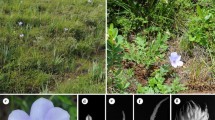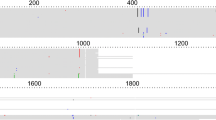Abstract
The chloroplast gene encoding ribulose-1,5-bisphosphate-carboxylase (rbcL) was sequenced for phylogenetic analysis of 13 species (10 genera) in the tribePolygonatae s.l. of theLiliaceae-Asparagoideae. The data were analysed using maximum parsimony and neighbour-joining methods. There were 233 phylogenetically informative sites out of 1368 base pairs compared. The results suggest that there are three monophyletic groups withinPolygonatae s.l. with high bootstrap confidence values. Group A representsPolygonatae s.str., with generaMaianthemum, Smilacina, Convallaria, Disporopsis, andPolygonatum. Group B containsUvularia andDisporum and group C includesStreptopus, Tricyrtis, Clintonia, andProsartes. The study suggests thatPolygonatae s.l. are not a monophyletic group, including at least three groups of different phylogenetic origin. Monophyly of the taxa within groups A, B, and C is supported by the high bootstrap confidence values (85–100%) of the bootstrap replications for both parsimony and neighbour-joining methods. The differences between each group (calculated as 100x base substitutions per site) were 6.99–9.03 for group A and B, 4.92–7.35 for A and C, and 6.66–7.57 for B and C.
Similar content being viewed by others
References
Albert, V. A., Chase, M. W., Mishler, B. D., 1993: Character state weighting for cladistic analysis of protein-coding DNA sequences. — Ann. Missouri Bot. Gard.80: 753–766.
Baker, J. G., 1875: Revision of the genera and species ofAsparagaceae. — J. Linn. Soc.14: 508–632.
—, 1879: A synopsis of theColchicaceae and the aberrant tribes ofLiliales. — J. Linn. Soc.17: 405–510.
Bentham, G., Hooker, J. D., 1883: Genera Plantarum.3: 748–837. — London: Reeve.
Berg, R. Y., 1962a: Morphology and taxonomic position ofMedeola, Liliaceae. — Skr. Norw. Vidensk Akad. Oslo.3: 1–55.
—, 1962b: Contribution to the comparative embryology of theLiliaceae: Scoliopus, Trillium, Paris, Medeola. — Skr. Norw. Vidensk Akad. Oslo.4: 1–64.
Björnstad, I. N., 1970: Comparative embryology ofAsparagoideae-Polygonateae-Liliaceae. — Nytt. Mag. Bot.17: 169–207.
Bousquet, J., Strauss, S. H., Li, P., 1992: Complete congruence between morphological andrbcL-based molecular phylogenetics in birches and related species ofBetulaceae. — Mol. Biol. Evol.9: 1076–1088.
Chase, M. W., Soltis, D. E., Olmstead, R. G., Morgan, D., Les, D. H., Mishler, B. D., Duvall, M. R., Price, R. A., Hills, H. G., Qiu, Y., Kron, K. A., Rettig, J. H., Conti, E., Palmer, J. D., Manhart, J. R., Sytsma, K. J., Michaels, H. J., Kress, W. J., Karol, K. G., Clark, W. D., Hedren, M., Gaut, B. S., Jansen, R. K., Kim, K., Wimpee, C. F., Smith, J. F., Furnier, G. R., Strauss, S. H., Xiang, Q., Plunkett, G. M., Soltis, P. S., Swensen, S. M., Williams, S. E., Gadek, P. A., Quinn, C. J., Eguiarte, L. E., Golenberg, E., Learn, G. H., Graham, S. W., Barrett, S. C. H., Dayanandan, S., Albert, V. A., 1993: Phylogenetics of seed plants: an analysis of nucleotide sequences from the plastid generbcL. — Ann. Missouri Bot. Gard.80: 528–580.
Conover, M. V., 1983: The vegetative morphology of the reticulate-veinedLiliiflorae. — Telopea2: 401–412.
—, 1991: Epidermal patterns of the reticulate-veinedLiliiflorae and their parallel veined allies. — Bot. J. Linn. Soc.107: 295–312.
Conran, J. G., 1987: A phenetic study of the relationship ofDrymophila R. Br. within the reticulate veinedLiliiflorae. — Austral. J. Bot.35: 283–300.
—, 1989: Cladistic analysis of some net-veinedLiliiflorae. — Pl. Syst. Evol.168: 123–141.
Conti, E., Fischbach, A., Sytsma, K. J., 1993: Tribal relationships inOnagraceae: implications fromrbcL sequence data. — Missouri Bot. Gard.80: 672–685.
Dahlgren, R. M. T., Clifford, H. T., 1982: The monocotyledons—a comparative study. — London: Academic Press.
—, —, Yeo, P. F., 1985: The families of monocotyledons, structure, evolution, and taxonomy. — Berlin, Heidelberg: Springer.
Doebley, J., Durbin, H., Golenberg, E. D., Clegg, M. T., Ma, D. P., 1990: Evolutionary analysis of the large subunit of carboxylase (rbcL) nucleotide sequences among the grasses (Graminae). — Evolution44: 1097–1108.
Don, D., 1825: Prodromus florae napalensis. — London.
—, 1841: A monograph ofStreptopus, with the description of a new genus first separated from it. — Trans. Linn. Soc. (London)18: 525–534.
Dumortier, B. C., 1829: Analyse des familes des plantes. — Aine: Tournay.
Duvall, M. R., Clegg, M. T., Chase, M. W., Clark, W. D., Kress, W. J., Hills, H. G., Eguiarte, L. E., Smith, J. F., Gaut, B. S., Zimmer, E. A., Learn, G. H., 1993a: Phylogenetic hypothesis for the monocotyledons constructed from therbcL sequence data. — Ann. Missouri Bot. Gard.80: 607–619.
—, Learn, G. H., Eguiarte, L. E., Clegg, M. T., 1993b: Phylogenetic analysis ofrbcL sequences identifiesAcorus calamus as the primal extant monocotyledon. — Proc. Natl. Acad. Sci. USA90: 4641–4644.
Fedorov, A. A., (Ed.), 1969: Chromosome numbers of flowering plants. — Acad. Sci. USSR, V. L. Komorov Botanical Institute Leningrad.
Felsenstein, J., 1992: PHYLIP (Phylogeny Inference Package) version 3.4.
Fitch, W. M., 1977: On the problem of discovering the most parsimonious tree. — Amer. Naturalist111: 223–257.
Gaut, B. S., Muse, S. V., Clark, W. D., Clegg, M. T., 1992: Relative rates of nucleotide substitution at therbcL locus of monocotyledonous plants. — J. Mol. Evol.35: 292–303.
Giannasi, D. E., Zurawski, G., Learn, G. H., Clegg, M. T., 1992: Evolutionary relationships of theCaryophillidae based on comparativerbcL sequences. — Syst. Bot.17: 1–5.
Goldberg, A., 1989: Classification, evolution, and phylogeny of the families of monocotyledons. — Smithsonian Contr. Bot.71: 1–74.
Hara, H., 1987: Notes towards a revision of the Asiatic species of genusSmilacina. — J. Fac. Sci. Univ. Tokyo III.,14: 137–159.
—, 1988: A revision of the Asiatic species of the genusDisporum. — Univ. Mus. Bull. (Univ. Tokyo)31: 163–209.
Heng, L., 1990: Infrageneric systems of the genusMaianthemum. — Acta Bot. Yunn., Suppl.3: 1–12.
Hong, D., Zhu, X., 1990: Report on karyotypes of 6 species in 4 genera ofPolygonatae from China. — Acta Phytotaxon. Sinica28: 185–198.
Howe, C. J., Fearnley, I. M., Walter, J. E., Dyer, T. A., Gray, J. C., 1985: Nucleotide sequences of the genes for the alpha, beta, and epsilon subunits of wheat chloroplast ATP synthase. — Pl. Mol. Biol.4: 333–345.
Huber, H., 1969: Die Samenmerkmale und Verwandtschaftsverhältnisse der Liliifloren. — Mitt. Bot. Staatssamml. München8: 219–539.
Hutchinson, J., 1959: The families of flowering plants2: 591–621. — Oxford: Clarendon.
Jones, Q., 1951: A cytotaxonomic study of the genusDisporum in North America. — Contr. Gray Herb.173: 1–40.
Kimura, M., 1981: Estimation of evolutionary distances between homologous nucleotide sequences. — Proc. Natl. Acad. Sci. USA78: 454–458.
Khokhryakov, A. P., 1975: Somatic evolution of the monocotyledons. — Moscow: Nauka. (In Russian.)
Krause, K., 1930:Liliaceae. — InEngler, A., Prantle, K., (Eds): Die Natürlichen Pflanzenfamilien, pp. 227–391. — Leipzig: Engelmann.
Kron, K. A., Chase, M. W., 1993: Systematics of theEricaceae, Empetraceae, Epacridaceae, and related taxa based uponrbcL sequence data. — Ann. Missouri Bot. Gard.80: 735–741.
LaFrankie, J. V., 1986: Transfer of the species ofSmilacina toMaianthemum (Liliaceae). — Taxon35: 584–589.
Michaels, H. J., Scott, K. M., Olmstead, R. G., Szaro, T., Jansen, R. K., Palmer, J. D., 1993: Interfamilial relationships of theAsteraceae: insights fromrbcL sequence variation. — Ann. Missouri Bot. Gard.80: 742–751.
Moon, E., Kao, T., Wu, R., 1987: Sequence of the chloroplast encodedatp β-atp E-trn M gene clusters from rice. — Nucl. Acids Res.15: 4358–4359.
Morgan, D. R., Soltis, D. E., 1993: Phylogenetic relationships among members ofSaxifragaceae sensu lato based onrbcL sequence data. — Ann. Missouri Bot. Gard.80: 631–660.
Nakai, T., 1936: Subdivision ofConvallariaceae. — Japan J. Bot.12: 145–150.
Olmstead, R. G., Bremer, B., Scott, K. M., Palmer, J. D., 1993: A parsimony analysis of theAsteridae sensu lato based onrbcL sequences. — Ann. Missouri Bot. Gard.80: 700–722.
Price, R. A., Palmer, J. D., 1993: Phylogenetic relationships of theGeraniaceae andGeraniales fromrbcL sequence comparison. — Ann. Missouri Bot. Gard.80: 661–671.
Qiu, Y., Chase, M. W., Les, D. H., Parks, C. R., 1993: Molecular phylogenetics of theMagnoliidae: cladistic analysis of nucleotide sequences from the plastid generbcL. — Ann. Missouri Bot. Gard.80: 587–606.
Rettig, J. H., Wilson, H. D., Manhart, H. D., 1992: Phylogeny of theCaryophyllales—gene sequence data. — Taxon41: 201–209.
Rodman, J., Price, R. A., Karol, K. G., Conti, E., Sytsma, K. J., Palmer, J. D., 1993: Nucleotide sequences of therbcL gene indicate monophyly of mustard oil plants. — Ann. Missouri Bot. Gard.80: 686–699.
Saitou, N., Nei, M., 1987: The neighbour-joining method: a new method for reconstructing phylogenetic trees. — Mol. Biol. Evol.4: 406–425.
Salisbury, R. A., 1866: Genera Plantarum. — London: John van Voort.
Schulze, W., 1983: Beiträge zur Taxonomie der Liliifloren 7.Asparagaceae. — Wiss. Z. Friedrich Schiller Univ. Jena31: 309–330.
Sen, S., 1974: Chromosome evolution inPolygonatae. — Bull. Bot. Soc. Bengal.28: 103–111.
Shinwari, Z. K., Terauchi, R., Utech, F. H., Kawano, S., 1994: Recognition of the new worldDisporum sectionProsartes asProsartes (Liliaceae) based on the sequence data ofrbcL gene. — Taxon (in press).
Smith, J. F., Kress, W. J., Zimmer, E. A., 1993: Phylogenetic analysis of theZingiberales based onrbcL sequences. — Ann. Missouri Bot. Gard.80: 620–630.
Soltis, D. E., Soltis, P. S., Clegg, M. T., Durbin, M., 1990:rbcL sequence divergence and phylogenetic relationships inSaxifragaceae sensu lato. — Proc. Natl. Acad. Sci. USA87: 4640–4644.
—, Morgan, D. R., Grable, A., Soltis, P. S., Kuzoff, R., 1993: Molecular systematics ofSaxifragaceae sensu stricto. — Amer. J. Bot.80: 1056–1081.
Swofford, D., 1993: PAUP: Phylogenetic Analysis Using Parsimony, ver. 3.1.1. — Computer program distributed by the Illinois Natural History Survey, Champaign, Il., USA.
Tai, T. H., Tanksley, S. D., 1990: A rapid and inexpensive method for isolation of total DNA from dehydrated plant tissue. — Pl. Mol. Biol. Report8: 297–303.
Takhtajan, A., 1980: Outline of the classification of flowering plants (Magnoliophyta). — Bot. Rev.46: 225–359.
—, 1987: Systema Magnoliophytorum, pp. 287–309. — Leningrad: Nauka.
Tamura, M. N., Utech, F. H., Kawano, S., 1992: Biosystematic studies inDisporum (Liliaceae-Polygonatae) IV. Karyotype analysis of some Asiatic and North American taxa with special reference to their systematic status. — Pl. Spec. Biol.7: 103–120.
Terachi, T., Ogihara, Y., Tsunewaki, K., 1987: The molecular basis of genetic diversity among cytoplasms ofTriticum andAegilops VI. Complete nucleotide sequences of therbcL genes encoding H- and L-type rubisco large subunits in common wheat andAegilops crassa 4x. — Japan. J. Genet.62: 375–388.
Therman, E., 1956: Cytotaxonomy of the tribePolygonatae. — Amer. J. Bot.43: 134–142.
Wilson, M. A., Gaut, B., Clegg, M. T., 1990: Chloroplast DNA evolves slowly in the palm family (Arecaceae). — Mol. Biol. Evol.7: 303–314.
Xiang, Q., Soltis, D. E., Morgan, D. R., Soltis, P. S., 1993: Phylogenetic relationships ofCornus L. sensu lato and putative relatives inferred fromrbcL sequence data. — Ann. Missouri Bot. Gard.80: 723–734.
Author information
Authors and Affiliations
Rights and permissions
About this article
Cite this article
Shinwari, Z.K., Kato, H., Terauchi, R. et al. Phylogenetic relationships among genera in theLiliaceae-Asparagoideae-Polygonatae s.l. inferred fromrbcL gene sequence data. Pl Syst Evol 192, 263–277 (1994). https://doi.org/10.1007/BF00986256
Received:
Revised:
Accepted:
Issue Date:
DOI: https://doi.org/10.1007/BF00986256




